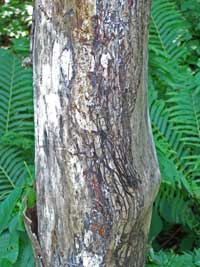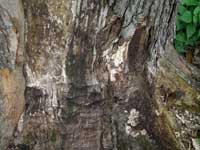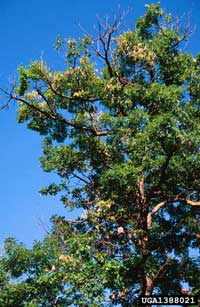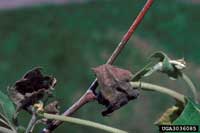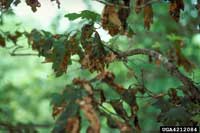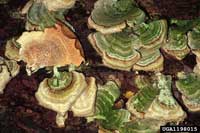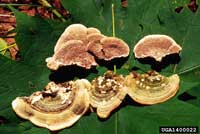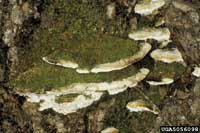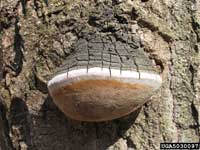Extension > Garden > Diagnose a problem > What's wrong with my plant? > Deciduous > Ironwood (Ostrya) > Dead twigs or branches
Ironwood (Ostrya) > Trunk/branches > Dead twigs or branches
1 of 5
Armillaria root rot
Armillaria spp.
- Infected trees have poor growth, dead branches in the upper canopy, undersized and/or yellow leaves
- Flat white sheets of fungal growth (mycelial fans) between the bark and sapwood at the base of infected trees
- Thick black, shoestring-like fungus can sometimes be seen under the bark, around roots and in the soil around the base of the tree
- Wood is decayed, white, soft and spongy; this may extend from the base of the tree well up into the trunk
- Trees frequently break or fall over in storms
- Clusters of honey-colored mushrooms may grow at the base of the tree in fall
- More information on Armillaria root rot
2 of 5
Twolined chestnut borer
Agrilus bilineatus
- Leaves in upper canopy turn brown and dead branches are present
- Damage visible mid to late summer
- S-shaped galleries beneath bark
- 1/8 inch D-shaped exit holes may be visible
- Adult has bluish black body with two light stripes running down the wing covers
- Larvae are approx. 1 inch long and white with 2 spines at the abdomen tip
- More information on Twolined chestnut borer
3 of 5
Anthracnose
Apiosporopsis carpinea
- Leaves have reddish brown irregular spots or blotches
- Leaves may drop prematurely
- Reddish brown cankers on branches; may become sunken and surrounded by ridges of wound wood with age
- Dead twigs and wilted, bleached leaves on branches with girdling cankers
- More information on Anthracnose
4 of 5
Sapwood rot
Cerrena unicolor
- Dead branches within the canopy
- Yellowing to brown leaves may be present
- Groups or rows of small (
- Shelf fungi are white to greenish gray and have concentric rings on the surface
- Wood below fungal shelves is yellowish to white, spongy, crumbly and decayed
- Bark around fungal shelves is killed and often falls off
- Common on trees stressed by drought, winter injury, wounds, mechanical injury or other factors
- More information on Heart rot
5 of 5
Heart rot
Phellinus spp. and Oxyporus populinus
- Fungal fruiting bodies arise along the stem, near a pruning wound, crack or other wound
- Phellinus fungi grow are up to 8" across, hoof-shaped and dark gray above, tan below with a white margin
- Oxyporus shelf fungi are 6" across, almost as thick and often covered with green moss
- The canopy may show no symptoms or may have small yellowing leaves or dead branches depending on the extent of the trunk decay
- In cross section of the trunk, the wood at the center is discolored, soft, crumbling, stringy or spongy
- More information on heart rot




